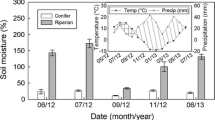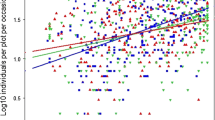Summary
The desert woodlouse Hemilepistus reaumuri is one of the most abundant macroscopic invertebrates in North Africa, the Arabian steppes, semi-desert and desert, and the Negev desert Israel.
The main purposes of our study were:
-
1.
To investigate the feeding behaviour of H. reaumuri in the field and the laboratory, with special attention to the importance of soil and perennials in the isopods' diet.
-
2.
To estimate annual energy flow and soil turnover by the isopods and to relate it to the role of isopods in the desert ecosystem.
The results of field observations and feeding experiments in the laboratory show:
-
a)
That desert isopods are saprovores, herbivores and microbivores.
-
b)
That in order to survive the isopod should include soil particles and or soil minerals when feeding on vegetation.
-
c)
Annual ingestion was 10.3–38.6 kcals/m2, 3–12% of the available dead organic matter, and soil turnover 28.5–105.7 g/m2.
-
a)
It was hypothesized that by ingestion and defaecation of organic matter and inorganic soil particles, H. reaumuri alters the structure of the decomposition substrate and increase the rate of decomposition in the desert ecosystem.
Similar content being viewed by others
References
Berthet, P.: Mésure de la consommation d'oxygene des Oribatides (Acariens) de la litier des forets. In: Soil organisms (J. Doeksen, J. Van der Drift, eds.), pp.18–31. Amsterdam: North Holland 1963
Bocock, K.L.: The digestion and assimilation of food by Glomeris. In: Soil organisms (J. Doeksen, J. Van der Drift, eds.), pp. 85–91. Amsterdam: North Holland 1963
Boughey, A.S.: Contemporary readings in ecology. California: Dickenson Belmont 1969
Brereton, J. le Guy: The distribution of woodland isopods. Oikos 8, 85–106 (1957)
Bunnell, F.L., Dowding, P.: ABISKO: A generalized decomposition model for comparisons between tundra sites. In: Soil organisms and decomposition in Tundra (A.J. Holding et al., eds.). Stockholm: Tundra Biome Steering Committee 1974
Evenari, M.: Biomass studies on the desert perennial, Hammada scoparia. Unpublished data (1970)
Golley, F.B.: Energy dynamics of a food chain of an old-field community. Ecol. Monogr. 30, 187–206 (1960)
Hartenstein, R.: Feeding, digestion, glycogen and the environmental conditions of the digestive system in Oniscus asellus. J. Insect Physiol. 10, 611–621 (1964)
Holter, P.: Food utilization of the dung-eating Aphodius larvae (Scarabaeidae). Oikos 25, 71–79 (1974)
Van Hook R.I.: Energy and nutrient dynamics of spider and orthopteran populations in a grassland ecosystem. Ecol. Monogr. 41, 1–26 (1971)
Hubbell, S.P., Sikora, A., Paris, O.H.: Radiotracer, gravimetric and calorimetric studies of ingestion and assimilation rates of an isopod. Health Phys. 11, 1485–1501 (1965)
Ing, B.: Myxomycetes as food for other organisms. Proc. S. Lond. ent. nat. Hist. Soc. 1967, 18–23 (1967)
Lincoln, R.J.: A review of the species of Hemilepistus S.STR. Budde-Lund, 1885 (isopoda, porcellionidae) Bull. Br. Mus. nat. Hist. (Zool.) 20 (4), 109–130 (1970)
Linsemair, K.E.: The importance of family-specific “badges” for the cohesion of families in the social desert woodlouse, Hemilepistus reaumuri. Z. Tierpsychol. 31, 131–162 (1972)
Orshan, G., Diskin, S.: Seasonal changes in productivity under desert conditions. In: Functioning of terrestrial ecosystems at the primary production level. Proc. of the Copenhagen Symp. (F.E. Eckardt, ed.), UNESCO (1969)
Paris, O.H.: The ecology of Armadillidium vulgare (Isopoda: Oniscoidea) in California grassland; food, enemies and weather. Ecol. Monogr. 33, 1–22 (1963)
Paris, O.H., Sikora, A.: Radiotracer demonstration of Isopod herbivory. Ecol. 46, 729–734 (1965)
Petrusewicz, K., Macfadyen, A.: Productivity of terrestrial animals: Principles and methods. IPB Handbook No. 13 (1970)
Phillipson J.: Secondary productivity in invertebrates reproducing more than once in a lifetime (K. Petrusewicz, ed.), pp. 459–475. Warsaw-Krakow: Polish Academy of Sciences, Inst. Ecol. 1967
Raw, F.: Arthropoda (except Acari and Collembola). In: Soil biology (N.A. Burges, F. Raw, eds.), pp. 323–362 (1967)
Reichle, D.E.: Radioisotope turnover and energy flow in terrestrial isopod populations. Ecol. 48 (3), 351–366 (1967)
Reichle, D.E.: Relation of body size to food intake, oxygen consumption and trace element metabolism in forest floor arthropods. Ecol. 49, 538–542 (1968)
Schroeder, L.: Energy budget of larvae of Hyalophoracecropia (Lepidoptera) fed Acer negundo. Oikos 22, 256–259 (1971)
Smalley, A.E.: Energy flow of the salt marsh grass-hopper population. Ecol. 41, 672–677 (1960)
Sutton, S.L.: Woodlice, 144 pp. London: Ginn 1972
Wallwork, J.A.: Ecology of soil animals, 283 pp. New York: McGraw-Hill 1970
Wieser, W.: Untersuchungen über die Ernährung und den Gesamtstoffwechsel von Porcellio scaber (Crustacea: Isopoda). Pedobiologia 5, 304–331 (1965)
Wieser, W.: Copper and the role of isopods in degradation of organic matter. Science 153, 67–69 (1966)
Wieser, W.: Aspects of nutrition and the metabolism of copper in isopods. Amer. Zool. 8, 495–506 (1968)
Author information
Authors and Affiliations
Rights and permissions
About this article
Cite this article
Shachak, M., Chapman, E.A. & Steinberger, Y. Feeding, energy flow and soil turnover in the desert isopod, Hemilepistus reaumuri . Oecologia 24, 57–69 (1976). https://doi.org/10.1007/BF00545487
Received:
Issue Date:
DOI: https://doi.org/10.1007/BF00545487




